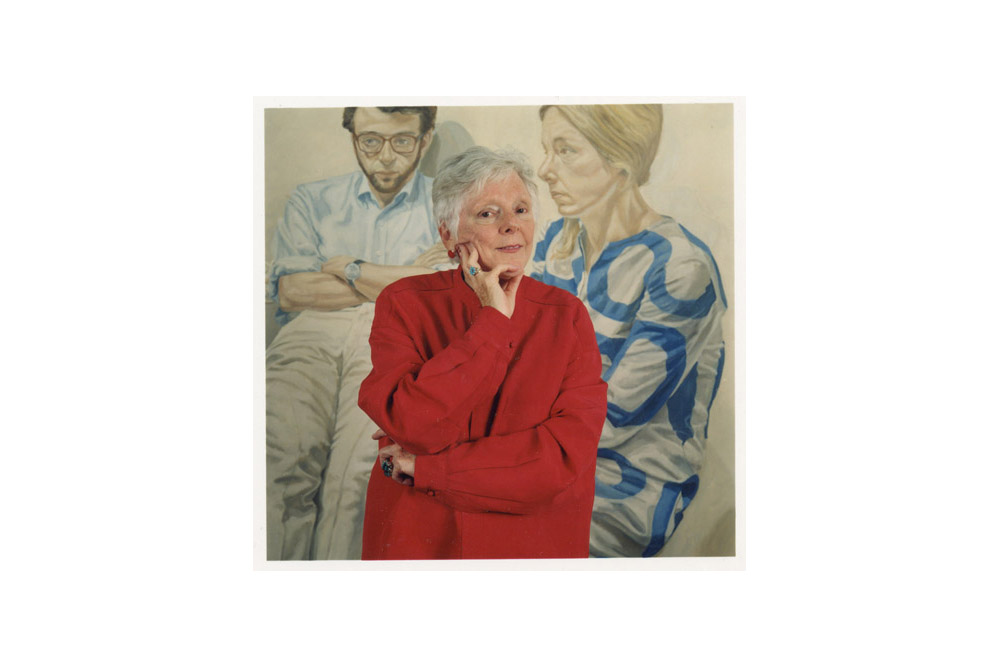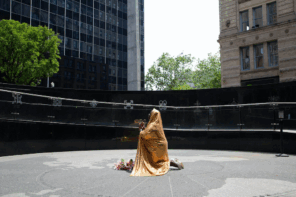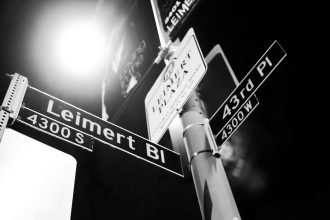In the summer of 1994, the end of my second year at the IFA and Linda Nochlin’s first, she came to stay with my boyfriend and me during a summer research trip to Paris. (She had arranged the apartment for us, in fact.) The first morning of her visit, I called through the door to ask if I could get her any breakfast. The door opened, and Professor Nochlin emerged, mostly but not entirely wrapped in a towel, and proceeded to give me a thorough and welcome education on the cultural nuances of the dairy section of French grocery stores.
Once she emerged from her room completely glammed out and had finished her fromage blanc, I asked her something, addressing her as Professor Nochlin. “Aruna,” she said, “I think we’ve come to the stage of our friendship where you should start calling me Linda.”
This moment sticks out in my mind as the start of my utter adoration of Linda – as a person and as an intellectual. For someone who had grown up with a great deal of shame about my body, seeing Linda’s matter-of-factness about her own physicality was revelatory. (I say “apparent” because of course none of our relationships with our own bodies are entirely matter of fact – they are always already shot through with complications, with ambivalence, with inadequacy. That’s why we dream of flying, or of being invisible. There’s always something a body cannot do.)
But this matter-of-factness about the body was not simply a matter of female empowerment. It became, for me, one of the most important intellectual lessons I learned from her.
Anyone who took a nineteenth-century class with Linda might remember, perhaps as vividly as I do, the way she talked about the prodigious number of bodies on display. Yes, there was the male gaze and the objectification of the female body and yadda yadda yadda, but that wasn’t really what Linda spent most time on. Instead, she would draw our attention to the ordinariness or banality of the bodies – Suzanne Manet’s double chin, or the fat knees of a Courbet nude, or the muscularity of the legs of a Cézanne, or the broadness of shoulders of a Degas. I was trained to look at every zit, every strained muscle, every sign of fatigue or age, every discomfort. (Though far fewer and farther between in the later nineteenth century, she would apply the same mode of viewing to the male body, too, I should say.)
She would force us to see these bodies not as nudes – as generalized images of beauty, as invitations or exhortations for us (whether feminists or not) to focus on how the erotics of that form were produced. Rather, she invited us to pay attention to those moments – would you forgive me if I borrowed the photographic notion of Barthes’s punctum? – where those erotics broke down in the face of the wonderful banality of flesh and virtuosity of paint.
This, to me, was the most anti-patriarchal gesture I could imagine – a refusal of the objectification of the female body by seeing the body as an object. It was a process of demystification. In the face of her eagle eye, the female body could no longer function either as a transcendent vessel of desire as in academic painting, or even as a vehicle of shock as the Realists would have it. It was just … ordinary.
But – and here is what I think is so illuminating about how Linda thinks – she delights in that ordinariness, in the facticity of how the body works (and, at times, fails to work). In part because it allows her to get at the painting – at the stuff of paint – whether she’s talking about a Bouguereau or a Picasso or a Jenny Saville. And it’s what allowed her to take the shocking power of the female body – a shockingness that painters have exploited to claim their avant-gardness for at least two centuries in the west – and put it firmly back into the realm of historical artifact. As an historical object, one can then tackle this shock, turn the analysis into a politics, without being seduced by its thrall.
It’s hard to imagine the female body as a kind of Medusa if you’re focused on her unusually long forearms or extra pudgy earlobes. “You take your shock, Sir,” she seemed to be saying in those graduate seminars, “I’d prefer to see with clear eyes.”
So trained am I in Linda’s ways of seeing that I often find myself surprised that not everyone thinks that way. I gave a lecture a few years ago in front of a large audience seated in a big auditorium; the screen was cinematic. The first slide I put up was Courbet’s Origin of the World – and I was entirely unprepared for the audible gasp I heard from the audience. (In fact I had to look up to see what everyone was looking at.)
None of this implies that Linda herself didn’t like to shock her audiences, I hasten to say. On another trip to Paris, a couple of years later, Linda stayed with us again. I was having a great time that year, haunting all the museums of Paris, revelling in near empty galleries with my friends. We had a game, the group of us graduate students in art history who hung out, to deal with the one annoyance that marred our enjoyment: every time we stood in front of a painting to talk about it, crowds of tourists would gather, almost crushing us to catch a free tour. One of our group suggested a game – when the crowds gathered, we would say more and more outrageous things about the painting. Whoever said the most outrageous thing without the crowd dispersing – in other words, the most convincingly outrageous thing – won the game. Linda, of course, being the most competitive person in the entire world, loved this idea.
She wanted to go to the Musée d’Orsay, which had just installed in their galleries Courbet’s Origin of the World, after the painting’s years of obscurity. The painting was, of course, dear to Linda’s heart, the subject of her art historical detective hunt in the 1980s to locate it in preparation for the landmark Courbet exhibition she organized with Sarah Faunce at the Brooklyn Museum in 1988. She later wrote in October about the search – “An Origin without an Original” – and the process of tracking it down in the personal collection of the family of Jacques Lacan, hidden behind a cover painted by the Surrealist painter Paul Masson.
We took our time getting to Origin in the galleries, stopping for long conversations in front of Burial at Ornans and The Studio and the landscapes and animal studies in the Courbet rooms. We edged our way through the throngs to get up close to Origin, and Linda started to tell me the twists and turns of her search for the painting. The crowds pressed closer, fascinated at first by the outrageousness of the painting itself – its shock value – and then by the story they were hearing by an obviously erudite and authoritative woman – one who could spin a tale, no less.
She turned to me and said: “You know, Aruna, the most interesting thing I discovered in my research? It wasn’t that Lacan owned it, or that Masson made the covering panel, or anything like that. It was that the woman who posed for it WAS COURBET’S MOTHER.”
My eyes went wide for a nanosecond until I realized what she was doing. The crowd, utterly appalled by what they took to be truth, dispersed. But that’s the thing – it was the truth in some way, because let’s face it, it’s always the mother. But even better was that in that one flip remark, Linda replaced one kind of shock – the pleasurable, titillating kind – with another, more profound one.
Linda passed away on the morning of October 29, 2017, after a long period in which her body broke down, became too much to bear. Its facticity became too much. It is now the right time to say that Linda has definitively and forever won the game that we used to play, our friends and I. Congratulations, wonderful and brilliant woman. But in your spirit of joy, competitiveness, and endless wit and insight, we will play on.
























“Origin” as Courbet’s mother! Thank you Sky for a great morning wake up read.